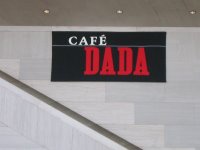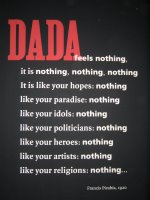 "We had lost confidence in our culture. Everything had to be demolished. We would begin again after the 'tabula rasa.' At the Cabaret Voltaire we began by shocking common sense, public opinion, education, institutions, museums, good taste, in short, the whole prevailing order."
"We had lost confidence in our culture. Everything had to be demolished. We would begin again after the 'tabula rasa.' At the Cabaret Voltaire we began by shocking common sense, public opinion, education, institutions, museums, good taste, in short, the whole prevailing order."— Marcel Janco, Dada at Two Speeds
 So last Sunday, my girl and I hop on our bikes and head downtown to take in the Dada exhibit on display at the National Gallery of Art. The temperature is a bit on the cool side for this time of year, but the brilliance of the sunlight drifting down from an almost cloudless sky makes it easy to ignore the pinpricks of cool air that poke us through the fibers of our clothing.
So last Sunday, my girl and I hop on our bikes and head downtown to take in the Dada exhibit on display at the National Gallery of Art. The temperature is a bit on the cool side for this time of year, but the brilliance of the sunlight drifting down from an almost cloudless sky makes it easy to ignore the pinpricks of cool air that poke us through the fibers of our clothing. We take the usual route there, starting on the Custis Trail and eventually merging onto the Mount Vernon Trail, then climbing up to take the 14th Street Bridge over to the Mall. The cherry blossoms are starting to open in DC, drawing locals and tourists alike with the lure of a casual stroll or cautious ride around the tidal basin in the semi-shade of hundreds of pink umbrellas. It's still too early to see them in all their glory, regardless of what the local news stations are saying, but the crowds are beginning to gather nonetheless.
We take the usual route there, starting on the Custis Trail and eventually merging onto the Mount Vernon Trail, then climbing up to take the 14th Street Bridge over to the Mall. The cherry blossoms are starting to open in DC, drawing locals and tourists alike with the lure of a casual stroll or cautious ride around the tidal basin in the semi-shade of hundreds of pink umbrellas. It's still too early to see them in all their glory, regardless of what the local news stations are saying, but the crowds are beginning to gather nonetheless. Once in DC, I stop a couple times to snap some pix of random fixies, each waiting patiently for its motor to return. Rolling again, we dodge the occasional slack-jawed gawker and tunnel-visioned driver to make our way to 4th Street, then head west, eventually rolling across the bumpy cobblestone swatch that links the two halves of the Gallery. We scout an open bike pole and lock up outside the West building. It's good to see that the poles are all but hidden beneath heaps of bicycles, a sign of things to come as oil prices continue on their one-way journey ever upward.
Once in DC, I stop a couple times to snap some pix of random fixies, each waiting patiently for its motor to return. Rolling again, we dodge the occasional slack-jawed gawker and tunnel-visioned driver to make our way to 4th Street, then head west, eventually rolling across the bumpy cobblestone swatch that links the two halves of the Gallery. We scout an open bike pole and lock up outside the West building. It's good to see that the poles are all but hidden beneath heaps of bicycles, a sign of things to come as oil prices continue on their one-way journey ever upward. We cross the street and enter the East building. Just beyond the revolving door, we present our packs for the obligatory "everyone's a terrorist until proven otherwise" baggage search (Dada was highly controversial in its time, sure, but I think the day has passed when it could generate opposition of an extremely violent nature. Cezanne, on the other hand...). After the rifling, we check our packs (a process that includes a desultory x-raying), get our claim ticket, then make our way around to the stairs.
We cross the street and enter the East building. Just beyond the revolving door, we present our packs for the obligatory "everyone's a terrorist until proven otherwise" baggage search (Dada was highly controversial in its time, sure, but I think the day has passed when it could generate opposition of an extremely violent nature. Cezanne, on the other hand...). After the rifling, we check our packs (a process that includes a desultory x-raying), get our claim ticket, then make our way around to the stairs.  Almost immediately, the unsuspecting gallery goer is presented with the first of several things that surely has the Dadaists spinning at redline rpms in their respective graves: a huge banner overhanging the third floor escalator proclaiming the joyous presence of the CAFE DADA. Famished and walk-weary bourgeois, take note! See the fading, nearly impotent relics of a banished movement from the safety of eight decades of memory loss (plus a quarter inch of plate glass), then venture up to the mezzanine level to reward yourself with our twelve dollar Picabia salad. Alas, nothing escapes...
Almost immediately, the unsuspecting gallery goer is presented with the first of several things that surely has the Dadaists spinning at redline rpms in their respective graves: a huge banner overhanging the third floor escalator proclaiming the joyous presence of the CAFE DADA. Famished and walk-weary bourgeois, take note! See the fading, nearly impotent relics of a banished movement from the safety of eight decades of memory loss (plus a quarter inch of plate glass), then venture up to the mezzanine level to reward yourself with our twelve dollar Picabia salad. Alas, nothing escapes... So, up the stairs we go, arriving at the entrance to the exhibit, which is located on the second floor. The place is packed; a good sign, given the present day relevance of most of the art on exhibit in these rooms. We squeeze our way in through the throng to take it all in.
So, up the stairs we go, arriving at the entrance to the exhibit, which is located on the second floor. The place is packed; a good sign, given the present day relevance of most of the art on exhibit in these rooms. We squeeze our way in through the throng to take it all in.  The first thing we see is a macabre loop of silent footage from World War I projected on a wall directly opposite the entrance. The images in the film are disturbing: troops, long dead, march by, their gaunt, tired faces belie the immortality granted by the grainy magic of film. Schoolchildren, instructed by a frantic teacher, don gas masks and scurry for shelter like overgrown mantids. Bodies litter a bomb-ravaged landscape like trees uprooted in a storm. Amputees happily try on crude prostheses, smiling approvingly at a verisimilitude only they can see. A soldier, his face disfigured by shrapnel, gets a new nose and cheeks grafted to a pair of eyeglasses a dutiful doctor hooks over his ears—the lifeless opera mask covers up living flesh in an effort to counterfeit life—there ya go, son, good as new, now, back to the front!
The first thing we see is a macabre loop of silent footage from World War I projected on a wall directly opposite the entrance. The images in the film are disturbing: troops, long dead, march by, their gaunt, tired faces belie the immortality granted by the grainy magic of film. Schoolchildren, instructed by a frantic teacher, don gas masks and scurry for shelter like overgrown mantids. Bodies litter a bomb-ravaged landscape like trees uprooted in a storm. Amputees happily try on crude prostheses, smiling approvingly at a verisimilitude only they can see. A soldier, his face disfigured by shrapnel, gets a new nose and cheeks grafted to a pair of eyeglasses a dutiful doctor hooks over his ears—the lifeless opera mask covers up living flesh in an effort to counterfeit life—there ya go, son, good as new, now, back to the front!  Dada originated, in part, as a response to the horrors of what many of its adherents perceived as an unecessary and particularly dehumanizing war, one that was unprecedented in its facile mating of large-scale industry and large-scale bloodshed. For the Dadaists, modernity, far from freeing humankind from the brutality of war, had instead simply mechanized and streamlined the whole nasty business with the beguiling elegance and efficiency of mass production. The film goes a long way in a short time toward making their case and setting the mood for the works that follow. Grim stuff, to be sure.
Dada originated, in part, as a response to the horrors of what many of its adherents perceived as an unecessary and particularly dehumanizing war, one that was unprecedented in its facile mating of large-scale industry and large-scale bloodshed. For the Dadaists, modernity, far from freeing humankind from the brutality of war, had instead simply mechanized and streamlined the whole nasty business with the beguiling elegance and efficiency of mass production. The film goes a long way in a short time toward making their case and setting the mood for the works that follow. Grim stuff, to be sure. We move through the first room, and I snap a few pix when I can get a clear shot. In the second room, a replica of the original Prussian Archangel hangs overhead, forever frozen in mid goosestep, the embodiment of (and perhaps inspiration for) the slur "fascist pig."
We move through the first room, and I snap a few pix when I can get a clear shot. In the second room, a replica of the original Prussian Archangel hangs overhead, forever frozen in mid goosestep, the embodiment of (and perhaps inspiration for) the slur "fascist pig." Note: The sign around the pigman's midriff reads "I come from Heaven, from Heav'n on high"—a line from a popular German Christmas carol; the dangling placard reads, "In order to understand this work of art completely, one should drill daily for twelve hours with a heavily packed knapsack in full marching order in the Tempelhof Field (an area in Berlin where troops trained for battle)."
 I take a picture of the sardonic figure, and from out of nowhere a tall guard, attracted automatically to my flash like a moth to candlelight, approaches me from an adjacent room. He leans down and says in a gruff voice, "No pictures, no pictures." The man withdraws just as quickly as he came in, but not before I note uneasily the striking similarity between the uniform adorning this gallery constable and that of the porcine officer hovering above me.
I take a picture of the sardonic figure, and from out of nowhere a tall guard, attracted automatically to my flash like a moth to candlelight, approaches me from an adjacent room. He leans down and says in a gruff voice, "No pictures, no pictures." The man withdraws just as quickly as he came in, but not before I note uneasily the striking similarity between the uniform adorning this gallery constable and that of the porcine officer hovering above me. The "request" is odd, to say the least. The Gallery made no mention of a ban on photography, but my girl and I put it together that it's probably a restriction demanded by the current owners of the artworks. More odd is the fact that quality photos of many of the pieces are displayed in the pages of a couple of free 'zines found throughout the Gallery (not to mention on the Web). And perhaps most odd is that this restriction seems to fly in the face of all that Dada stood for. Which means that now I have to take some shots, just as a matter principle. So I switch off the flash and use the bodies of those around me to screen my highly subversive behavior from the authorities. The results are the pix in this post, many of which are of even poorer quality than I usually manage, thanks to low light, odd angles, and the obvious lack of setup time. So be it.
The "request" is odd, to say the least. The Gallery made no mention of a ban on photography, but my girl and I put it together that it's probably a restriction demanded by the current owners of the artworks. More odd is the fact that quality photos of many of the pieces are displayed in the pages of a couple of free 'zines found throughout the Gallery (not to mention on the Web). And perhaps most odd is that this restriction seems to fly in the face of all that Dada stood for. Which means that now I have to take some shots, just as a matter principle. So I switch off the flash and use the bodies of those around me to screen my highly subversive behavior from the authorities. The results are the pix in this post, many of which are of even poorer quality than I usually manage, thanks to low light, odd angles, and the obvious lack of setup time. So be it. We continue into the adjoining rooms, each named for the city where the works they contain were created: Zurich, Berlin, Hannover, Cologne, New York, Paris. The media and the forms they take run the gamut: collage, assemblage, oil paint, watercolors, graphite, pen and ink, wood, photomontage, covers from early Dada 'zines, and the ever-controversial "Readymade," Marcel Duchamp's coinage for "Found Art," among others. A replica of Duchamp's Bicycle Wheel is pictured at left. Of it, Duchamp said,
We continue into the adjoining rooms, each named for the city where the works they contain were created: Zurich, Berlin, Hannover, Cologne, New York, Paris. The media and the forms they take run the gamut: collage, assemblage, oil paint, watercolors, graphite, pen and ink, wood, photomontage, covers from early Dada 'zines, and the ever-controversial "Readymade," Marcel Duchamp's coinage for "Found Art," among others. A replica of Duchamp's Bicycle Wheel is pictured at left. Of it, Duchamp said,- " To set the wheel turning was very soothing, very comforting, a sort of opening of avenues on other things than material life of every day. I liked the idea of having a bicycle wheel in my studio. I enjoyed looking at it, just as I enjoyed looking at the flames dancing in a fireplace. It was like having a fireplace in my studio, the movement of the wheel reminded me of the movement of flames."
 After the exhibit, we pedal back to Clarendon, taking Wilson Boulevard up through Rosslyn as a way of avoiding the much steeper Key Boulevard hill (aka, DT's Hill). We hit Hard Times for some veggie chili, then head over to DT's to help him brew his latest batch of beer, a nice Brown Ale. After brewing, we transfer my IPA and his Imperial Stout from their primary buckets into carboys, where each receives a generous helping of whole hops in a mesh bag for that little extra something. Can't wait to taste these when they're done.
After the exhibit, we pedal back to Clarendon, taking Wilson Boulevard up through Rosslyn as a way of avoiding the much steeper Key Boulevard hill (aka, DT's Hill). We hit Hard Times for some veggie chili, then head over to DT's to help him brew his latest batch of beer, a nice Brown Ale. After brewing, we transfer my IPA and his Imperial Stout from their primary buckets into carboys, where each receives a generous helping of whole hops in a mesh bag for that little extra something. Can't wait to taste these when they're done. The Dada exhibit runs through Sunday, May 14. If you're in the area and have a couple of hours on your hands, it's well worth the time. You'll appreciate the parallels between that era and the present one as you take a little trip back to a time when the naked ass of art still had the power to shock. Do yourself a favor, though, ride your bike there. Duchamp would approve.
The Dada exhibit runs through Sunday, May 14. If you're in the area and have a couple of hours on your hands, it's well worth the time. You'll appreciate the parallels between that era and the present one as you take a little trip back to a time when the naked ass of art still had the power to shock. Do yourself a favor, though, ride your bike there. Duchamp would approve."For us, art is not an end in itself...it is an opportunity for the true perception and criticism of the times we live in."
— Hugo Ball, German Dadaist, poet, and founder of Cabaret
Voltaire, an "artist tavern" that opened in 1913 in Zurich
 POSTSCRIPT 1: The Dada Student Guide—an otherwise interesting and informative introduction to Dada that's available for free inside the Gallery—begins its discussion with, "Like the edgiest rock and hip-hop, Dada was young, smart, crude, angry, and outrageous," curiously and unforgivably failing to note the more apt comparison to punk. Oh well.
POSTSCRIPT 1: The Dada Student Guide—an otherwise interesting and informative introduction to Dada that's available for free inside the Gallery—begins its discussion with, "Like the edgiest rock and hip-hop, Dada was young, smart, crude, angry, and outrageous," curiously and unforgivably failing to note the more apt comparison to punk. Oh well.POSTSCRIPT 2: It occurs to me that for a federally funded institution like the National Gallery of Art to feel comfortable displaying nihilistic and (some may say) subversive statements, like those from Francis Picabia that appear on the "Nothing" banner in the pic somewhere above, surely means that the powers that be feel no threat from the threadbare ghosts of Dada. I'm grateful that the works are on display, but at the same time I think that a society's willingness to embrace counterculture like a mischievous little stepchild (think "Lust for Life" as the soundtrack for those Royal Carribean Cruise Line commercials) does not bode well for the transformational power of art.












1 comment:
Fight the power! I just recently read something bashing the "no photography allowed" rules in museums. I wish I could remember what/where it was, cuz I seem to recall it was a decent story.
nice write-up, too ;-)
Post a Comment